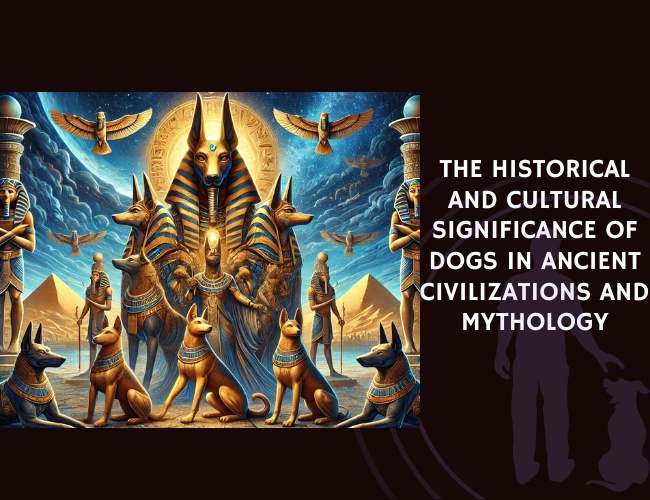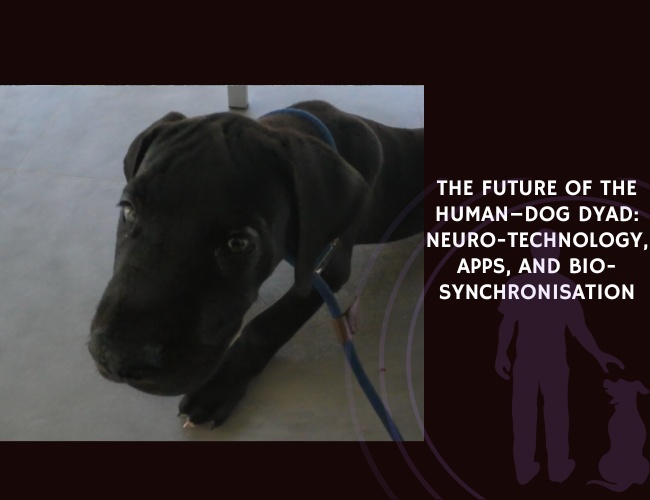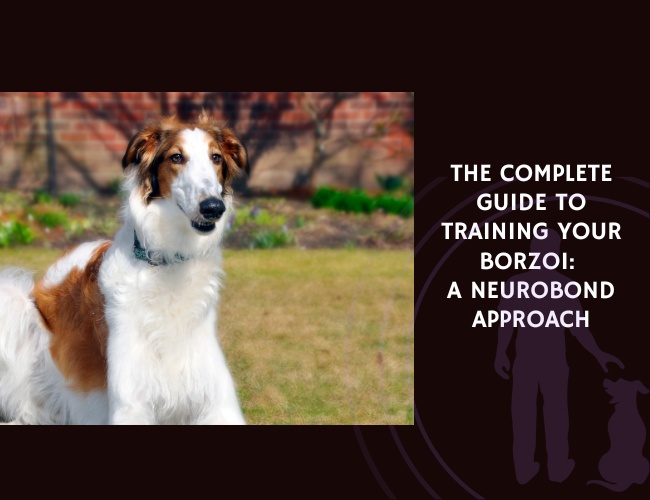Introduction to Dogs in Ancient Civilizations
The historical journey of dogs alongside humans spans over millennia, filled with remarkable shifts and roles that have evolved considerably. From early domestication by primitive hunters to their esteemed status as sacred beings, dogs have woven their way into the fabric of numerous ancient societies. This chapter delves into the multifaceted historical relationship between humans and dogs, highlighting the intriguing transformation of dogs from mere practical companions to revered spiritual symbols.
Practical Companionship
Initially, dogs played an essential role in the day-to-day survival of ancient humans. Early domesticated dogs were indispensable in tracking and hunting prey, making them vital companions for survival. Their keen senses and loyalty made them ideal partners in hunts and protective guardians of camps and property. In agricultural societies, dogs helped in herding livestock and safeguarding farms from predators, underlining their utility in everyday life.
Spiritual and Cultural Evolution
As civilizations advanced, so did the roles and perception of dogs. They began to transcend their utilitarian roles and were often seen as spiritual protectors and symbols of loyalty. In several ancient cultures, dogs were believed to have connections with the divine. This spiritual reverence is illustrated vividly in mythologies, religious texts, and societal practices.
Artistic and Archaeological Evidence
Artifacts from ancient Egypt, Greece, and Mesopotamia often depict dogs, revealing their symbolic and practical significance. Statues, pottery, and cave paintings show the various roles dogs held, ranging from hunting partners to spiritual guides. Such depictions underscore the deep-rooted bond and high regard ancient humans had for their canine companions.
Examples from Key Ancient Civilizations
To fully appreciate the diversity and richness of dogs’ roles, it’s important to explore specific examples from key ancient civilizations:
Ancient Egypt
The Egyptians revered dogs profoundly, as evidenced by their association with Anubis, the jackal-headed god who guarded the underworld and presided over mummification rituals. Anubis’ connection with a jackal or dog-like figure conveyed protection and transition between life and death.
Mesopotamia
Dogs in Mesopotamia were closely tied to the goddess Gula, the deity of healing. They were believed to have protective and healing properties, ascribing dogs a significant spiritual role in the wellbeing of individuals. Early texts and artifacts from this region also show evidence of dog domestication and personalized naming practices, indicating a deep personal bond.
Greece and Rome
Greek and Roman mythology richly features dogs as both heroic and fearsome creatures. For instance, Cerberus, the three-headed dog, guarded the gates of the underworld, preventing the dead from leaving. Meanwhile, Argos, the loyal dog of Odysseus, symbolized unwavering faithfulness and an enduring human-canine bond.
China
Ancient Chinese culture celebrated dogs in various spiritual contexts, believing they warded off evil spirits. The imperial Pekingese breed, often kept by royalty, exemplified the high esteem in which dogs were held. Additionally, dogs were featured in the Chinese zodiac, symbolizing traits like loyalty and protection.
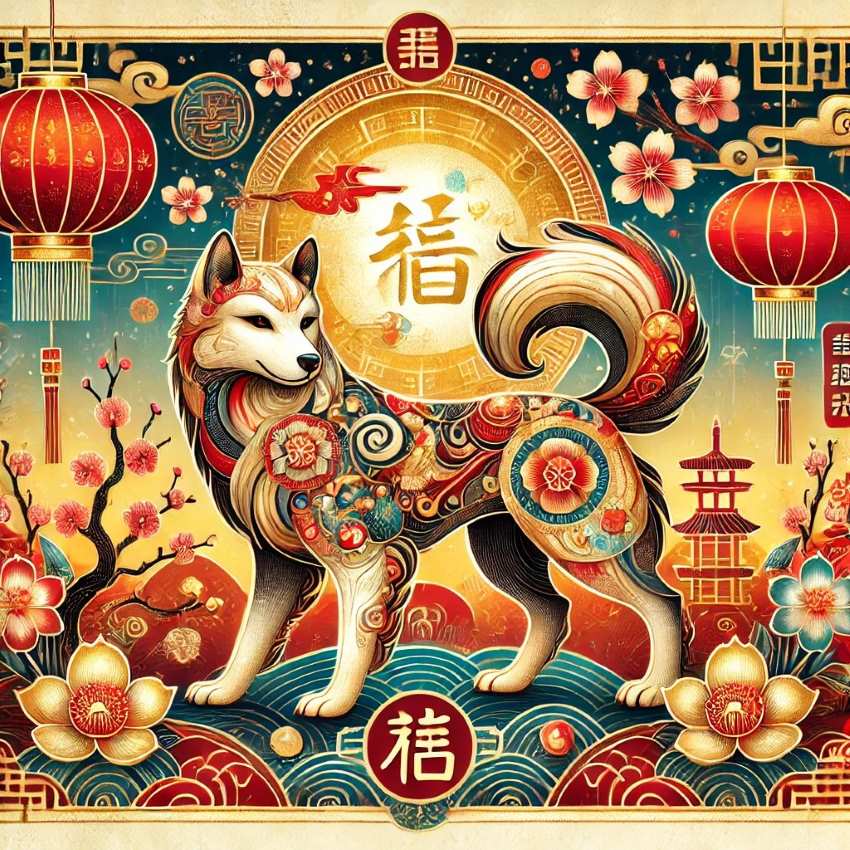
Recurring Themes
Across these ancient civilizations, several common themes emerge:
- Protection and Loyalty: Dogs were consistently seen as protective beings, both in practical and spiritual realms.
- Companionship: Their unwavering loyalty made them cherished companions in life and honored presences in death rituals.
- Spiritual Significance: Numerous myths and religious practices placed dogs in pivotal roles, reflecting an enduring spiritual connection.
As we explore the unique histories, mythologies, and traditions of dogs in various ancient cultures, it becomes clear that the bond between humans and dogs is not only timeless but also deeply rooted in shared experiences and mutual reliance. In the following chapters, we will delve into specific civilizations, uncovering the nuanced roles dogs played in Egyptian, Mesopotamian, Greek, Roman, Chinese, and indigenous societies.
Dogs in Ancient Egyptian Culture
The Significance of Anubis in Egyptian Mythology and Death Rituals
Ancient Egypt is well-known for its complex mythology and the distinct roles of various deities. Among these gods, Anubis stands out with his jackal-headed form, strongly associated with death and the afterlife. Anubis was revered as the guardian of the underworld, embodying the transition between life and death. His image, reflecting that of a jackal, symbolized protection and loyalty, attributes commonly linked to dogs. As a deity, Anubis played a crucial role in embalming and mummification rituals, overseeing the weighing of the heart ceremony, which determined a soul’s fate in the afterlife. This connection to divine judgment and protection made Anubis a central figure in Egyptian spirituality.
Practical Roles of Dogs in Egyptian Society
Beyond their spiritual and mythological relevance, dogs in ancient Egypt were valued for their practical roles. They were employed as hunters, aiding in tracking and capturing prey, which was essential for food resources and sporting events. Additionally, dogs were tasked with guarding properties, including homes and temples, protecting these spaces from intruders and possible robberies. This dual role highlights the versatility and significance of dogs in daily Egyptian life, functioning both as invaluable companions and protectors.
Evidence of Dog Reverence in Art and Burial Practices
The high regard for dogs in ancient Egypt is evident not only in their mythology but also through the art and burial practices of the time. Dogs are frequently depicted in Egyptian art, appearing in statues, pottery, and paintings. These depictions illustrate their importance and status within society. This reverence extended into the afterlife, as evidenced by burial practices involving dogs. Some dogs were mummified and buried alongside their human companions, signifying their significance and the deep bond between them even after death.
Through examining the prominent role of Anubis, the practical uses of dogs in hunting and protection, and the extensive evidence of dog reverence in art and burial practices, it becomes clear that dogs held a unique and multifaceted place in ancient Egyptian culture. This intricate relationship set the foundation for the varied roles of dogs in other ancient civilizations.
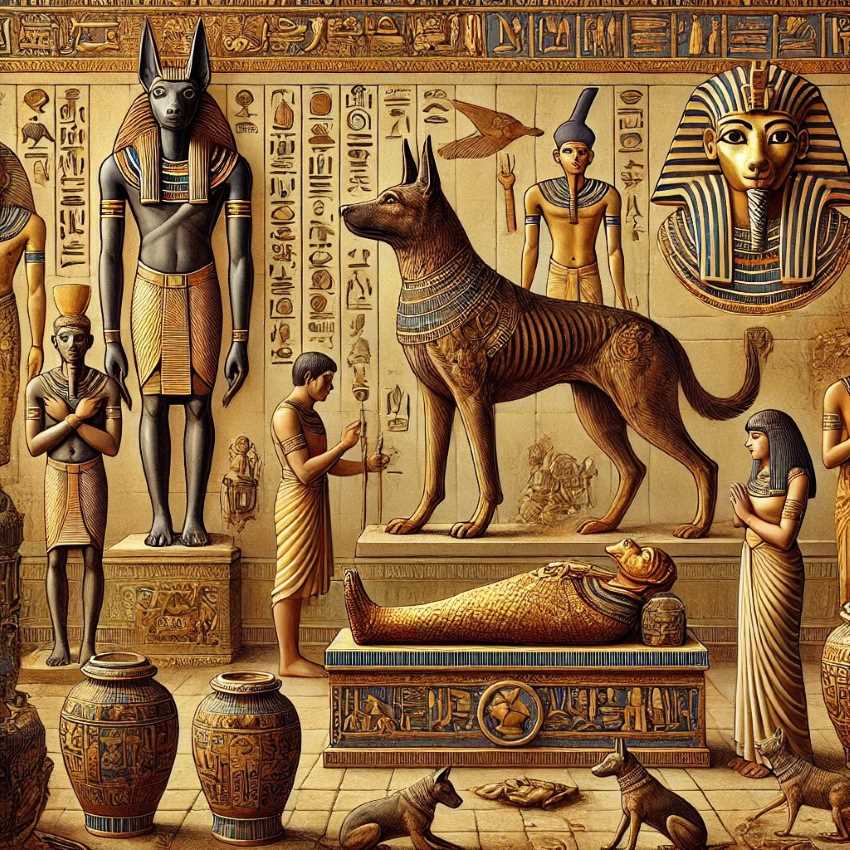
Mesopotamian Dog Culture
Connection between Dogs and the Healing Goddess Gula
Ancient Mesopotamian cultures held dogs in high regard, especially in connection to the goddess Gula, who was associated with healing and medicine. Dogs were seen as sacred animals that could ward off evil spirits and promote health. In this context, dogs were not just practical companions but also vital to spiritual and health-related practices.
Early Evidence of Dog Domestication and Naming Practices
Mesopotamia is one of the earliest regions where we find evidence of dog domestication. Inscriptions and texts reveal that dogs were an integral part of daily life, and naming practices highlight the special bond between humans and their canine companions. Ancient texts have shown that people would give personal names to their dogs, reflecting their deep affection and the high value they placed on them.
Dogs’ Roles in Protection and Spiritual Healing
Dogs in Mesopotamian society had multiple roles. They were practical protectors, guarding property and livestock. This physical form of protection was vital for the safety of the community. In the spiritual realm, dogs were believed to assist in healing practices. The presence of dogs in healing rituals, often linked to Gula, emphasized their role in ensuring well-being and safeguarding souls from evil.
- Protection of Property
- Spiritual Healing Rituals
Dogs’ multifaceted roles in Mesopotamian society showcase their importance beyond mere utility. They were protectors, healers, and companions, deeply embedded in both the spiritual and daily lives of the people.
This chapter illustrates how dogs in Mesopotamian culture transcended their roles as simple companions, embodying spiritual significance and practical utility, a theme that resonates throughout many ancient cultures.
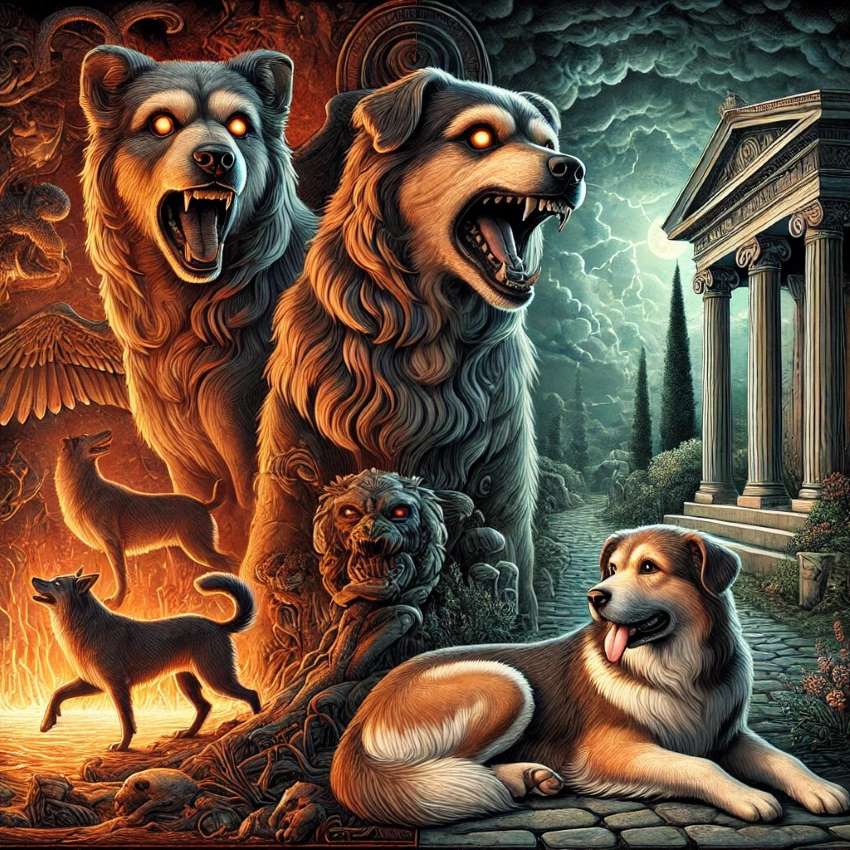
Dogs in Greek and Roman Mythology
Cerberus: Guardian of the Underworld
One of the most fascinating dog figures in Greek mythology is Cerberus, the formidable three-headed dog with a serpent’s tail, who guarded the gates of Hades. Cerberus played a crucial role in the underworld, ensuring that the souls of the dead could not escape and that the living could not enter without permission. This mythological creature not only highlighted the protective nature of dogs but also underscored their perceived spiritual importance. Cerberus’ fierce image served as a powerful symbol of loyalty and vigilance in guarding sacred spaces.
Argos: The Embodiment of Faithfulness
Argos, the loyal dog of Odysseus, stands as a timeless symbol of unwavering loyalty and faithfulness. In Homer’s epic poem The Odyssey, Argos waited patiently for his master’s return for twenty years. Despite neglect and old age, Argos recognized Odysseus upon his return, only to pass away after fulfilling his duty of reuniting with his master. This poignant story highlights the deep bond between humans and dogs, reflecting the values of loyalty and devotion that transcend time.
Practical Roles of Dogs in Greco-Roman Society
Beyond their mythological representations, dogs held various practical roles in Greek and Roman societies. These ancient civilizations utilized dogs for several purposes that were integral to daily life:
- Hunting Companions: Dogs were indispensable in hunting, aiding in tracking and capturing game. Their keen senses and agility made them perfect partners in the hunt, providing valuable support to their human counterparts.
- Herding and Protection: Dogs were also essential in herding livestock, particularly sheep and goats. By protecting herds from predators and keeping them organized, dogs played a key role in maintaining the agricultural stability of these societies.
- Guardians and Companions: In both Greek and Roman cultures, dogs served as guardians of homes and properties. Their protective nature and loyalty made them reliable defenders against intruders. Additionally, dogs were cherished companions, especially among the elite, offering emotional support and companionship.
The multi-faceted roles of dogs in Greco-Roman life underscore their importance as both practical assets and cherished companions. These roles reflect the adaptability and utility of dogs, as well as the emotional bonds they shared with humans.
The diverse ways dogs were revered and utilized in Greek and Roman mythology and daily life highlight their enduring legacy as protectors, companions, and symbols of loyalty. This deep connection continues to influence our perceptions of dogs today, illustrating their timeless place in the fabric of human society.
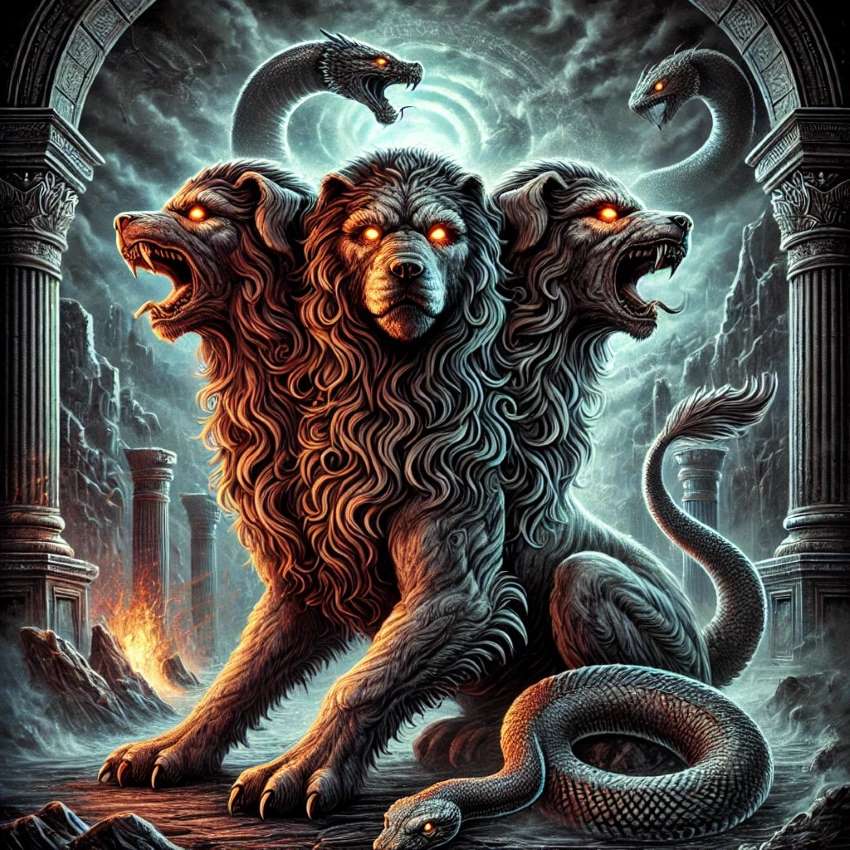
Ancient Chinese Dog Traditions
Dogs as Spiritual Protectors
Dogs have held esteemed positions as spiritual protectors in ancient China. It was commonly believed that dogs could ward off evil spirits and deliver protection against malevolent forces. This belief was so pervasive that dog statues and images were frequently placed at the entrances of homes and temples to keep negative energies at bay. This was more than superstition; it was a cultural norm deeply ingrained in the society’s spiritual practices.
The Pekingese and Imperial Culture
One of the most notable aspects of ancient Chinese dog traditions is the special status given to the Pekingese breed. These small, lion-like dogs were cherished by royalty and nobility, symbolizing both luxury and reverence. The Pekingese were considered sacrosanct and were often found lounging in the opulent halls of imperial palaces. Their association with the divine and imperial authority made them much more than mere pets; they were sacred beings deserving of deep respect.
The Pekingese were also protected by strict imperial edicts. Owning one was exclusively a privilege of the royal family, and commoners caught with these dogs could face severe penalties. This special status not only made the Pekingese a symbol of imperial majesty but also embedded them within the social and cultural framework of ancient China.
Dogs in the Chinese Zodiac
Another fascinating aspect of dogs in ancient Chinese culture is their role in the Chinese zodiac. The dog is one of the twelve zodiac animals, symbolizing loyalty, honesty, and reliability. According to the zodiac, those born in the Year of the Dog carry these positive attributes, being seen as honest and responsible individuals who are never afraid to fight injustice.
The inclusion of the dog in such a significant spiritual and cultural system underscores the immense respect and adoration the Chinese had for these animals. Dogs were seen as integral parts of both earthly existence and cosmic harmony, bridging the physical and spiritual realms.
Transition
These ancient Chinese dog traditions reflect a multi-dimensional view of dogs, integrating them deeply into spiritual, cultural, and social life. Dogs were guardians of both the material and spiritual worlds, as shown by their protective roles, their esteemed status in imperial culture, and their symbolic significance in the Chinese zodiac.
Dogs in Indigenous Cultures
The cultural significance of dogs among various indigenous communities is profound and varied, reflecting their practical and spiritual roles. From the hunting grounds of Native American tribes to the mystic beliefs of Mesoamerican civilizations, dogs have been more than mere companions—they have been invaluable members of these societies.
Practical Roles in Native American Tribes
Native American tribes utilized dogs extensively for practical tasks. Dogs assisted in hunting by tracking and cornering game, supporting their human companions in securing food. Beyond hunting, dogs were integral to transportation. Before the arrival of horses, some tribes used dog-pulled sleds known as “travois” to carry goods across distances. These sleds were essential for nomadic tribes, helping transport their homes and belongings.
Moreover, dogs served as vigilant guardians. They protected campsites from wild animals and alerted their owners to potential threats. The multifaceted purposes of dogs in Native American societies underscore their vital contribution to daily survival and security.
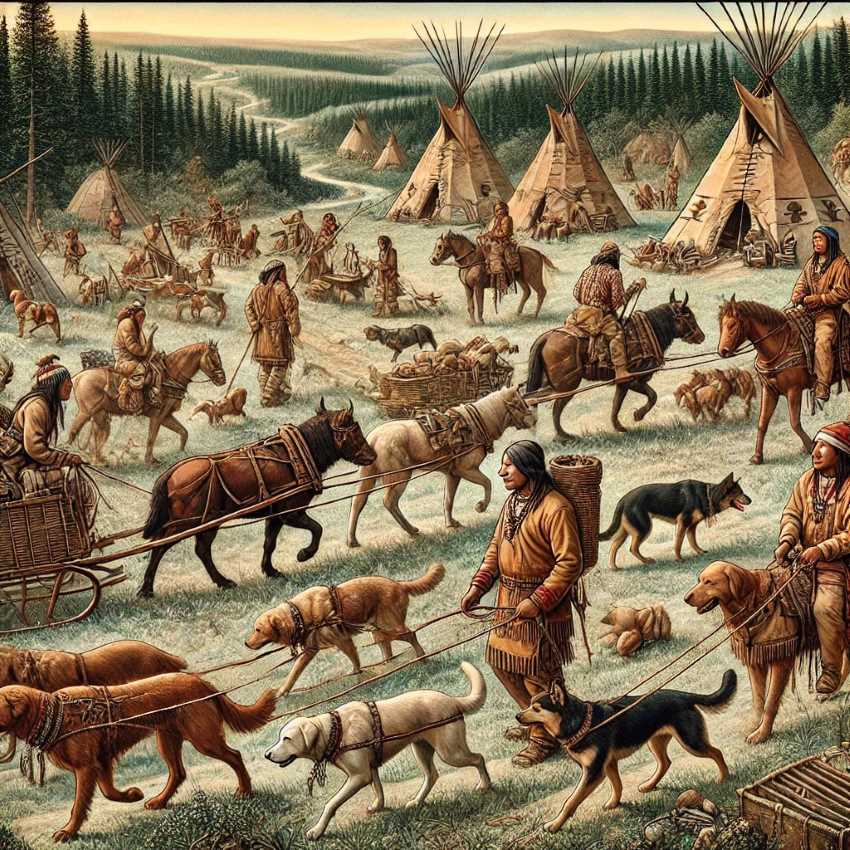
The Spiritual Significance of the Xoloitzcuintli
One striking example of spiritual reverence is the role of the Xoloitzcuintli in Mesoamerican civilizations. Commonly known as the “Mexican Hairless Dog,” the Xoloitzcuintli was believed to possess spiritual powers. The Aztecs and other Mesoamerican peoples considered this breed a guide for the souls of the deceased. In their mythology, these dogs were said to escort the dead through the underworld, ensuring their safe passage to the afterlife.
This belief was so entrenched that Xoloitzcuintlis were often buried alongside their owners to aid them in the afterlife. The spiritual status of the Xoloitzcuintli highlights how dogs could transcend their earthly roles and become celestial guides.
Comparative Roles Across Indigenous Societies
When comparing the roles of dogs across various indigenous groups, common themes emerge, despite geographical and cultural differences.
- Protection and Guardianship:
- Across the Americas, dogs were cherished as protectors both in the physical and spiritual realms.
- Whether guarding homes or guiding souls, dogs symbolized safety and transition between worlds.
- Symbols of Loyalty:
- Indigenous myths frequently illustrate dogs as embodiments of loyalty and companionship.
- Stories from these cultures often highlight the unwavering faithfulness of dogs, reinforcing their treasured place in society.
- Spiritual Beliefs:
- Dogs were seen as spiritual beings in many indigenous cultures.
- They were included in ceremonies, rituals, and mythologies, often holding roles that connected the living with the divine or ancestral spirits.
These recurring themes showcase a deep and intrinsic bond between indigenous peoples and their canine companions. The roles of dogs transcended mere practicality, embedding themselves in the spiritual and cultural fabric of these societies.
Transition to Next Chapter
As we delve further into the historical context of dogs, it is essential to explore archaeological evidence and the early breeds that have shaped this enduring relationship. Understanding the physical artifacts and depictions can provide a tangible connection to the significance of dogs in ancient cultures.
Archaeological Evidence and Ancient Dog Breeds
Historical Evidence of Early Dog Breeds
Throughout history, dogs have been more than just companions to humans. They have been integral to various ancient cultures. Archaeological discoveries have provided insights into early breeds such as Salukis, Molossians, and Xoloitzcuintlis, emphasizing their diverse roles in ancient times.
Salukis
The Saluki, often dubbed the “Royal Dog of Egypt,” is one of the most ancient dog breeds. This breed is depicted in Egyptian tomb art dating back to 2100 BC. Salukis were highly prized for their speed and hunting prowess, often used to chase down gazelles and other swift game. This breed’s elegant appearance and significant presence in Egyptian art highlight its esteemed status.
Molossians
Molossians, ancestors of today’s Mastiffs, were powerful dogs originating from the ancient region of Molossia, part of modern Albania. These dogs served various roles, from guarding property to participating in warfare. The Romans admired Molossians for their strength and loyalty, using them in gladiatorial arenas and as protectors of their households. The enduring image of these formidable dogs reflects their crucial role in ancient societies.
Xoloitzcuintlis
The Xoloitzcuintli, also known as the Mexican Hairless dog, holds a significant place in Mesoamerican cultures, including the Aztecs and Mayans. This breed was believed to be a spiritual guide, aiding souls in their journey to the afterlife. The discovery of Xoloitzcuintli remains in burial sites underscores their importance in both life and death. These dogs were often depicted in artifacts, demonstrating their revered status.
Artifacts and Depictions in Ancient Art
Dogs have been prominently featured in ancient art and artifacts across cultures.
- Egyptian Art: In Egypt, dogs were commonly depicted in tomb paintings, demonstrating their role in both the earthly and the spiritual realms. These depictions often show dogs accompanying their masters in hunting scenes or resting near them, signifying their loyalty.
- Greek Pottery: Greek pottery frequently illustrates dogs in various contexts, from domestic scenes to mythological portrayals like Cerberus, the three-headed dog guarding the underworld. These artistic depictions emphasize the multifaceted roles of dogs in Greek culture.
- Roman Sculptures: Roman sculptures and mosaics also highlight dogs, particularly in hunting and guarding scenarios. The intricate details in these artworks reveal the admiration Romans had for their canine companions.
Burial Practices Involving Dogs
Dogs’ importance is further highlighted by the burial practices involving them in various cultures.
- Egyptian Burials: In ancient Egypt, dogs were often mummified and buried alongside their owners, reflecting their sacred status and the belief in their protective roles in the afterlife.
- Mesoamerican Graves: The practice of including dogs in burial sites was also prevalent in Mesoamerican cultures. The Xoloitzcuintli, in particular, was buried with the deceased to serve as a guide in the afterlife, underscoring their spiritual significance.
- European Tombs: In Europe, particularly among the Celts and Anglo-Saxons, dogs were buried with their masters, a testament to their valued companionship and loyalty. These burials indicate the deep-seated bond between humans and dogs throughout history.
Archaeological findings across different civilizations provide a rich tapestry of the historical significance of dogs. From the esteemed Salukis in Egypt to the powerful Molossians in Rome and the spiritual Xoloitzcuintlis in Mesoamerica, these ancient breeds were integral to human life and culture. The enduring legacy of these bonds can be seen in art, artifacts, and burial practices, illustrating the timeless relationship between humans and their canine companions.
Modern Legacy and Cultural Impact
Contemporary Preservation Efforts for Ancient Dog Breeds
The bond between humans and dogs has been established for thousands of years, spanning across various civilizations and continuing to impact modern society. Today, numerous efforts aim to preserve ancient dog breeds, reflecting the rich history and heritage they represent. Breeds like the Xoloitzcuintli and Saluki are being protected and maintained through dedicated breeding programs and organizations. The Xoloitzcuintli, native to Mesoamerica, is renowned for its historical significance as a spiritual guide in the afterlife. Similarly, the Saluki, revered in ancient Egypt for its grace and hunting prowess, continues to be celebrated for its contributions to human history.
Preservation initiatives involve genetic studies, careful breeding practices, and public education to ensure the survival of these ancient breeds. By maintaining their unique characteristics and promoting awareness, these efforts help sustain the legacy of human-dog relationships that date back to antiquity.
Enduring Symbolism of Dogs in Modern Culture
Dogs have consistently symbolized loyalty, protection, and companionship, themes that remain relevant in contemporary culture. From literature and art to film and popular media, dogs are frequently depicted as devoted and faithful companions. This enduring symbolism highlights the deep emotional bonds that humans continue to share with their canine counterparts.
In modern times, dogs are celebrated in various cultural contexts. For example, the role of dogs in providing emotional support and companionship is widely acknowledged, reflecting their historical significance as protectors and loyal friends. The continuation of these themes from ancient myths and stories into today’s world demonstrates the everlasting connection between humans and dogs.

Continuing Traditions like Nepalese Kukur Tihar
One of the most heartwarming examples of the ongoing celebration of the human-dog bond is the Nepalese festival of Kukur Tihar. This festival, part of the larger Tihar festival, is dedicated entirely to honoring dogs. During Kukur Tihar, dogs are adorned with garlands, given treats, and worshiped as sacred beings. The celebration acknowledges the integral role dogs play in human lives, both in practical terms and within spiritual practices.
Kukur Tihar exemplifies how ancient traditions that revere dogs continue to thrive in modern times. This festival not only celebrates dogs but also reinforces the vital and cherished relationship humans have with these loyal animals.
As we continue to explore the cultural significance of dogs throughout history, we see the many ways in which they have influenced our lives and remained steadfast companions. The legacy of these ancient connections is evident in the preservation of breeds, their enduring symbolism, and continuing traditions that honor them.

